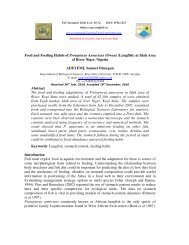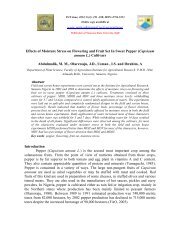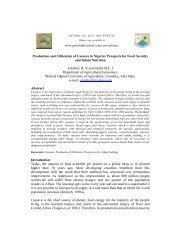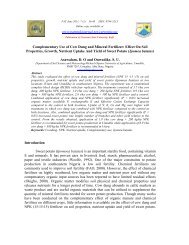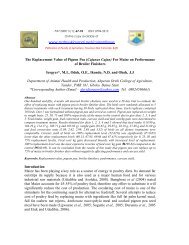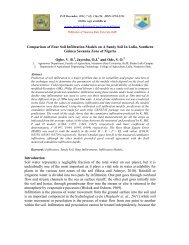View Publication - Production Agriculture and Technology Journal
View Publication - Production Agriculture and Technology Journal
View Publication - Production Agriculture and Technology Journal
You also want an ePaper? Increase the reach of your titles
YUMPU automatically turns print PDFs into web optimized ePapers that Google loves.
PAT June, 2012; 8 (1): 105 -110; ISSN: 0794-5213Online copy available atwww.patnsukjournal.net/currentissue<strong>Publication</strong> of Nasarawa State University, KeffiRelationship between Aggregate Stability, S<strong>and</strong>: Clay Ratio <strong>and</strong> ElectricalConductivity in Plantation SoilsEneje, R. C. 1 , <strong>and</strong> Kalu Samuel Anya11 Department of Soil Science And Agro-climatology, Michael Okpara University of <strong>Agriculture</strong> Umudike, Nigeria.Email: chizma2001@ yahoo.comAbstractA study was carried out at the Micheal Okpara University of <strong>Agriculture</strong>, Umudike, plantationfarms to monitor changes in aggregate stability s<strong>and</strong>/clay ratio <strong>and</strong> organic matter content inthese soils. Soil samples were collected from these plantations, (oil palm plantation <strong>and</strong>pineapple) with soil auger at two depths 0-51cm <strong>and</strong> 15-30cm <strong>and</strong> analyzed for selectedproperties. Results show that the soils under rubber plantation had the highest aggregatestability at both depths (70%-80%) compared to the other soils (26%-44%); soil underpineapple had the highest s<strong>and</strong>/clay ratio(1.94), while the soil under oil palm had the highestexchangeable sodium percentage(4.66%), compared to the other soils. There were directrelationship between soil aggregate stability <strong>and</strong> organic matter content <strong>and</strong> also betweens<strong>and</strong>/clay ratio <strong>and</strong> organic matter in the soils, however an inverse relationship exist betweenS<strong>and</strong> :Clay ratio <strong>and</strong> aggregate stability while the exchangeable sodium percentage(ESP) wasinversely related to aggregate stability. Generally the results show that the soils from theseplantation sites could be managed efficiently by specifically enhancing the ESP since all theproperties considered was had significant level of correlation with ESP with a coefficient ofdetermination (r 2 ) of about 62% indicating that the ESP exerted well over 60% control on theselected soil properties.Keywords: exchangeable sodium percentage, (ESP), s<strong>and</strong>:clay ratio, aggregate stability,plantation soils, coefficient of determination (r 2 )IntroductionAggregate stability of a soil defines the resistance of soil structure against mechanicalor physico-chemical destructive forces (Duniway, et. al., 2009), <strong>and</strong> soil structure is oneof the factors controlling plant growth by its influence on root penetration, soiltemperature <strong>and</strong> gas diffusion, water transport <strong>and</strong> seedling emergence <strong>and</strong> therefore itis an important soil characteristic for farmers. Soil structure defines the combination orarrangement of primary soil particles into compound elements, which are separatedfrom adjoining structural elements by surfaces of weakness. Thus soil texture, soilstructure, <strong>and</strong> the type of clay mineral, organic matter content <strong>and</strong> type, cementingagents as well as cropping history of a particular l<strong>and</strong> collectively influence theaggregate stability (Goldberg et. al., 1988). According to Gupta1 <strong>and</strong> Sharma (1990),the presence of excessive amounts of exchangeable sodium reverses the process of
PAT 2012; 8 (1): 105-110: ISSN: 0794-5213; Eneje <strong>and</strong> Kalu,: Relationship between Aggregate Stability…...106aggregation <strong>and</strong> causes soil aggregates to disperse into their constituent individual soilparticles. This is known as deflocculating <strong>and</strong> occurs in sodic soils which are reportedto contain high level of sodium relative to the other exchangeable cations (i.e. calcium,magnesium <strong>and</strong> potassium). Soils around the Micheal Okpara University of <strong>Agriculture</strong>have been subjected o different plantation crops such as oil palm, pineapple, citrus, <strong>and</strong>rubber; these economic plants have suffered neglect both in management <strong>and</strong> inproliferation. The African oil palm Elaeis guineensis is native to West Africa, occurringbetween Angola <strong>and</strong> Gambia They are used in commercial agriculture in the productionof palm oil. They grow in a wide range of soil types, provided good drainage <strong>and</strong> pHbetween 4 <strong>and</strong> 7; tolerates periodic flooding or a high water table; many soils arealluvial in nature, (Hartley, 1988). Research reports of the Department of Botany <strong>and</strong>Plant Pathology (2009), Purdue University also indicates that plantation plants likepineapple cannot st<strong>and</strong> water logging, though the plant is surprisingly drought tolerant,adequate soil moisture is necessary for good fruit production. While natural rubber is anelastomer (an elastic hydrocarbon polymer) that was originally derived from a milkycolloidal suspension, or latex, found in the sap of some plants. The purified form ofnatural rubber is the chemical polyisoprene, which can also be produced synthetically.Natural rubber is used extensively in many applications <strong>and</strong> products, as is syntheticrubber. The soil requirement of the plant is generally well-drained weathered soilconsisting of laterite, lateritic types, <strong>and</strong> sedimentary types, nonlateritic red or alluvialsoils. (Wikipedia, 2008)It is obvious that these three high economic utility crops when effectively managedcan help eradicate or reduce the global economic recess of many nations. Therefore theobjective of this study was to determine the relationship between s<strong>and</strong>/clay ratio,aggregate stability <strong>and</strong> exchangeable sodium percentage of soils exposed to rubber, oilpalm <strong>and</strong> pineapple plantations, to obtain repeatable soil quality information which ifapplied would enable sustainable productivity of these plantation crops.Materials <strong>and</strong> MethodsStudy SiteSoils were collected from the rubber plantation, oil palm plantation <strong>and</strong> pineappleorchard at Michael Okpara University of <strong>Agriculture</strong>, Umudike located on latitude 5 028’ North <strong>and</strong> longitude 7 0 32’ East with an elevation of 122m above sea level. The areais characterized by mean annual rainfall range of 1512 – 2731mm <strong>and</strong> relative humidityof 63-80% (N.R.C.R.I, Umudike, 2005).Sample Collection <strong>and</strong> Laboratory AnalysisSoil samples were collected in triplicates from the plantation sites, with soilauger at two depths (0-15cm <strong>and</strong> 15-30cm) put into a paper bag labeled <strong>and</strong> taken into
PAT 2012; 8 (1): 105-110: ISSN: 0794-5213; Eneje <strong>and</strong> Kalu,: Relationship between Aggregate Stability…...107the laboratory for analysis. The soil physical properties analyzed were; particle sizedistribution determined by the hydrometer method of Bouyoucous, (1951) as modifiedby Osodeke, (1997), exchangeable K, Ca, Mg <strong>and</strong> Na determined by extracting soilsamples in 1N NH 4 OAC, <strong>and</strong> the filtrate collected for elemental determination (Jones,2001).The s<strong>and</strong>-clay ratio was calculated using the formula:S<strong>and</strong>/Clay Ratio = % S<strong>and</strong>----------------------------equation 1% ClayAggregate stability was determined by the mean weight diameter as described byKemper <strong>and</strong> Chepil, (1965), percent mean weight diameter (%MWD) was calculatedusing the equation below;_%MWD = ∑ XiWi x 100/1------------------------------------------equation 2Where; _Xi = Arithmetic mean diameter of i = 1 <strong>and</strong> sieve opening (mm)Wi = Mi/MtMi = soil sample in the respective sieve after drying (g)Mt = Total weight of initial materials.The exchangeable sodium percentage (ESP) was calculated using the formula below:ESP = Exchangeable {(Na) / (Ca + Mg + K + Na)} x 100----------equation 3Data AnalysisData collected was subjected to analysis of variance (ANOVA) using a 3X2 factorial inR<strong>and</strong>omized complete block design (RCBD). Means were separated using Fisher’s leastsignificant difference FLSD at 5% probability level. Graphical plots showing therelationships between the selected soil properties <strong>and</strong> for the different l<strong>and</strong> use historywas carried outResults <strong>and</strong> DiscussionsSoil aggregates measured by percent mean weight diameter, (MWD %) were highlystable in the rubber plantation soil, this may be attributed to high litter accumulation inthe rubber plantation soil <strong>and</strong> these leaves contain latex which improved the stability ofsoil aggregates <strong>and</strong> increased the organic matter level of the soil, this observation issupported by the reports of Krull (2004), who also observed that as organic matterincreased, aggregate stability also increased. (Table 1).
PAT 2012; 8 (1): 105-110: ISSN: 0794-5213; Eneje <strong>and</strong> Kalu,: Relationship between Aggregate Stability…...108Table 1: Physicochemical properties of plantation soils with depthPlantationtypeDepth of ofSampling(cm)S<strong>and</strong>/clayratioOrganicMatter(%)AggregateStability(%)ExchangeableSodium percentage(%)Rubber 0-15 1.13 5.34 0.72 2.03Rubber 15-30 0.72 2.36 0.8 1.58Pineapple 0-15 1.94 2.34 0.26 4.31Pineapple 15-30 1.68 1.71 0.28 3.88Oil palm 0-15 0.89 5.09 0.44 3.47Oil palm 15-30 0.52 3.89 0.29 4.66FLSD (0.05)P 0.32 0.79 0.25 1.7D 0.26 0.65 N.S N.SPXD N.S 1.1200.35 N.SGenerally for all the plantation type studied, aggregate stability was seen todecrease with depth except in the pineapple plantation soil. This may be due to the factthat the pineapple soils were mostly s<strong>and</strong>y (pineapple thrives well in well drained s<strong>and</strong>ysoils). This observation also supports the report that organic matter had a strongrelationship with the s<strong>and</strong>/clay ratio, as organic matter additions increased aggregationregardless of cation composition, as observed in this study (Figure 1), this observationagrees with an earlier report of Aldrich <strong>and</strong> Martin, (1954).The pineapple soils had the highest s<strong>and</strong>/clay ratio which reduced with depth in allthe plantations sites considered. The high s<strong>and</strong>/clay ratio in the pineapple soil probablyled to a low aggregate stability, this was also reported in a study by Kay <strong>and</strong> Angers,(1999) suggesting that clay content in the soil affected its aggregate stability. Theseobservations therefore supports the inverse relationship between s<strong>and</strong>/clay <strong>and</strong>aggregate stability observed in this study (Figure 1), as an increase in s<strong>and</strong>/clay ratio ledto a decrease in the aggregate stability in all the plantations considered. Theexchangeable sodium percentage was highest in the oil palm within the 15-30cm depth.This may be due to the high percentage of sodium in the exchange site relative to otherexchangeable cations. The exchangeable sodium percentage of soils decreased withdepth except in oil palm soil where it increased with depth. There was an inverserelationship between the exchangeable sodium percentage <strong>and</strong> the aggregate stability(Figure 1), this observation is supported by the report of Aldrich <strong>and</strong> Martin, (1954)that, as aggregate stability decreases the exchangeable sodium percentage increases.
PAT 2012; 8 (1): 105-110: ISSN: 0794-5213; Eneje <strong>and</strong> Kalu,: Relationship between Aggregate Stability…...109Summary <strong>and</strong> ConclusionThe results from this study showed that soils from the pineapple orchard had lowaggregate stability <strong>and</strong> a high s<strong>and</strong>/clay ratio <strong>and</strong> by implication the water retentioncapacity <strong>and</strong> the yield in the Pineapple orchard of the Michael Okpara University of<strong>Agriculture</strong>, Umudike may be affected. The study also established a relationshipbetween aggregate stability, s<strong>and</strong>: clay ratio <strong>and</strong> exchangeable percentage, resultsshowed an inverse relationship between aggregate stability <strong>and</strong> s<strong>and</strong> clay ratios of theplantation soil but direct relationship between OM <strong>and</strong> ESP of the studied soils,however the ESP explained to a greater degree (r 2 = 62%) the relationship between thesoil properties in pineapple rubber <strong>and</strong> palm plantation soils, therefore improvement ofexchangeable sodium percentage in the plantation soils in Michael Okpara University of<strong>Agriculture</strong>, would lead to sustainable productivity of these plantation crops since it hasa high degree effect on other soil properties.6.005.00OM = 0.0092x + 3.4249:R 2 = 0.0001MWD = -0.0278x + 0.5627:R2 = 0.0484s<strong>and</strong>:clay= -0.0798x + 1.4282:R 2 = 0.0716ESP = 0.525x + 1.4838:R 2 = 0.6178Values of measured soil parameer4.003.002.001.000.00R(0-15cm) R(15-20cm) PA(0-15cm) PA(15-20cm) OP(0-15cm) OP(15-20cm)Plantation types at various depthsFig 1: Relationship between s<strong>and</strong>:clay, OM, ESP <strong>and</strong> MWD of soils from different plantation sitess<strong>and</strong>:clay(%)OM(%)ESP(%)MWDLinear (OM(%))Linear (ESP(%))ReferencesAldrich, D. G. <strong>and</strong> Martin, J. P. (1954).A Chemical-Microbiological Study ofEffects of Exchangeable Cations on Soil Aggregation. Soil Sci. Soc Am J18:276-281
PAT 2012; 8 (1): 105-110: ISSN: 0794-5213; Eneje <strong>and</strong> Kalu,: Relationship between Aggregate Stability…...110Bouycocous, G.J., (1951). Direction for making mechanical analysis by thehydrometer Method. Soil Science 42:225-229Duniway, M., Herrick, J., Speath, K., Barger, N., Van zee, J., Benlap, J.(2009)Multiscale Variability of soil aggregates stability: Implications for Rangel<strong>and</strong>Hydrology <strong>and</strong> erosion. 62 nd society for Range management Annual paperNumber:07-11Goldberg, S., D.L. Suarez, <strong>and</strong> R.A. Glaubig. (1988). Factors affecting claydispersion <strong>and</strong> aggregate stability of arid-zone soils. Soil Sci.146:317–325.Growing pineapple at home. (2009). Lecture Notes of the Department ofBotany Plant Pathology, Purdue University. Retrieved fromhttp://www.btny.purdue.edu/Outreach/resources/Growing_a_Pineapple_at_Home.pdf on 2010-01-30Gupta, S. K. <strong>and</strong> Sharma, S. K. (1990). Response of crops to high exchangeable sodiumpercentage Irrigation Science 11:173-179. Central Soil Salinity ResearchInstitute, Karnal-132001 Haryana, IndiaHartley, C. W. S. (1988). The Oil Palm, (3 rd Ed.) Longman Scientific <strong>and</strong>Technical, Harlow, U.K.Jones, Benton Jr. (2001) Laboratory Guide for conducting soil tests <strong>and</strong> plant analysis, CRCPress, New York, Washington D.CKay, B. D., <strong>and</strong> D. A. Angers.( 1999). Soil structure. p. A229–A276. In: M. E.Sumner (ed.) H<strong>and</strong>book of Soil Science. CRC Press, Boca Raton, FL.Kemper, W. D., <strong>and</strong> Chepil, W. S., (1965). Size Distribution of aggregates, In Methodsof Soil Analysis (eds. Black, C. A. et. al. ) Agronomy 9(Part 1) Americansociety of Agronomy, MD,U.S.A pp 499-519Krull, S.E. (2004). Functions of soil organic matter <strong>and</strong> effects on soil properties.CSIRO. L<strong>and</strong> <strong>and</strong> water, P.M.B. 2 Glen Osmond.Natural Rubber, (2008). Retrieved from Wikipedia on 2010-01-30http://en.wikipedia.org/wiki/Natural_rubberNRCRI, Umudike (2005). National Root Crops Research Institute,Umudike BulletinOsodeke,V.E., (1997). A laboratory Manual for soil analysis, M.O.U.A, Umudike.



